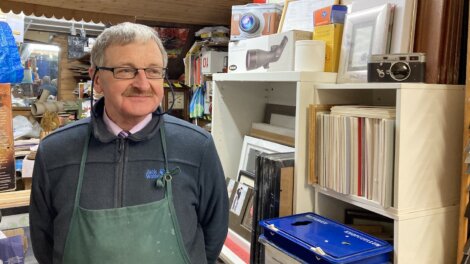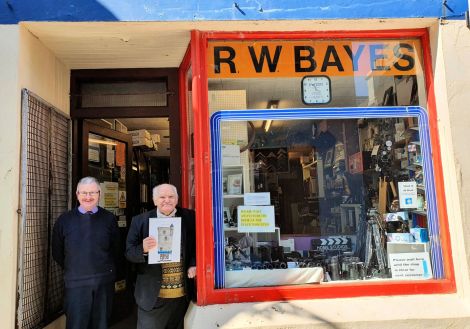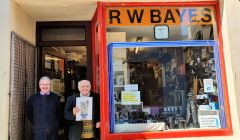Features / Memories of a life in an old-fashioned shop that became an institution
After R.W Bayes closed on Christmas Eve for the very last time, Neil Anderson looks back at more than 41 years in a job that became a way of life
IT WOULD be hard to work somewhere for over 41 years without storing a wealth of memories as has happened with my time at R.W. Bayes on Commercial Street.
The shop itself was opened in 1967 by Robert Bayes, always affectionately known as Bobby, a Londoner married in Shetland. He and his wife Lizzie were very familiar faces on ‘De Street’ for the 14 years running the business, still referred to today as Bobby Bayes.
Alister Smith started work with Bobby and Lizzie in the late 70s and was with them when Bobby decided to sell up and retire. Alister was to buy the shop in 1981 and earlier that year I had my interview to become his employee.
I say interview but it went more like this. I was walking up the road heading home when Alister’s car pulled up alongside me. I know the exact spot to this day. He told me he was thinking to buy Bayes and would I consider coming to work for him. The answer was yes and the rest as they say is history.
He never ever said why he had asked me, and I never asked him. I had however worked for him before when he was manager of the North Star cinema. He was having staffing difficulties and asked if I would be available to work some evenings to which I also said yes. I had many interesting and enjoyable times at both the cinema and bingo nights.
Before taking over the shop on 1 June 1981 Alister took two weeks off for a break as he knew he would be full on there in the early years of his venture. I started in the middle of May to help Bobby and Lizzie in their last two weeks while Alister was off.
Did I think I would still be there over forty 41 years later? It never entered my head.
Become a member of Shetland News
What started as a job became a way of life. This was not a standing behind the counter serving customers job. As many people have said, Bayes became an institution. In fact, soon after Alister and I started working together the late accountant James Daniel said as much.
The unique character of the shop grew and continued on till the end. Simple old-fashioned values, where it was always essential to try to do as much as possible for the customer and I hope over the years our failures were few.
Despite Alister being a man of gadgets and mechanical devices he never really embraced modern technology and although he went as far as buying a mobile phone he rarely if ever used it. Decades ago he bought an early computer which still sits gathering dust in an upstairs corner. The shop continued to function without such devices and no card payment machine ever entered the door. The thought of it made Alister mutter, “Aa yun peerie pieces a paper”. Not even a cash register company could haul him away from pulling out the cash drawer by hand.
The old-fashioned style of Bayes seemed to hold its own appeal and so many people would say how much they loved the atmosphere of the shop. One Shetlander now living in Orkney had occasion to call in on a trip home and later reported to her cousin that nothing had changed in Bayes except the two men were getting, “aulder, greyer and stooter”.
That said there have of course been many changes inside the shop while the premises has maintained a bit of an Olde Worldy feel.
Film products coming on the market, having their day and disappearing again
Products and services have gone through many phases. In the early days when film cameras were the thing there were quite a variety of film types. In roll films the 828 was about at an end but the 127, 620 and 120 were still popular, with only the 120 now readily available on the market. There was the occasional call for an Agfa rapid film while the 126 cassette was one of the main sellers.
In different models of 126 camera there was call for both flashcubes and magicubes. Some models using flashcubes had the batteries in the camera body while others needed a little grey box slotted on top, with both systems using two 825 batteries. Along came the magicube which did not need batteries. On pressing the shutter, a pin came up and unshipped a little trigger which struck a detonator and blew the bulb. Other flashbulbs were AG1 and AG3.
The 110 camera proved very popular with cassette loading but having a much smaller negative than the 126. The 110 in rectangular format while the 126 was square. Both of these camera types suffered from parallax problems and I am sure thousands of pictures were taken of auntie Jeannie and others with their heads cut off.
Along came the disc system with the simplest loading of not surprisingly a disc with the negatives arranged around the outside edge. Easy to use and handy in the pocket but suffering from the small scale of the negative making prints grainy with enlargement not practical above 5”x7”.
Then came the APS, Advanced Photographic System with a switch on the camera allowing the user to choose one of three formats including a panoramic version. It was something of a trick because the area of negative was the same while an electronic marker was placed on the negative allowing the printing machine to identify what format had been used.
The two versions of instant photography competed for some years until a legal case by Polaroid ruled that Kodak had infringed some copyright and they were forced to withdraw all their instant cameras. An amnesty was put in place where people could bring in their Kodak instant camera and we would give them a disc camera in its place before boxing up large numbers of the instant cameras and returning them to Kodak. It seems mad when you think back on it.
More and more products came on the market, had their day and disappeared again. Kodak’s instant printing system, Agfa’s ‘Family’ cine film system, Polaroid’s cine film system and so on.
Then to join the single lens reflex and pocket 35mm film cameras, along came digital and the world of photography was turned on its head. This system has gone from strength to strength and it is hard to imagine it ever fading away like so many of its predecessors.
With the digital market changing so rapidly, apparently introducing new models in what seemed like weekly succession, Alister became disillusioned with it and soon decided to stop stocking cameras altogether. There were other fish to fry.
In the early years of the shop Alister kept up his keen interest in letterpress printing. At one point he had three presses in the workshop and many drawers of type in various fonts. He printed letterheads, posters, membership cards and among other things funeral notices. These of course took priority over everything else. On occasions when Alister went away on holiday it fell to me to do these and I could see what made Alister enjoy the printing process. It was fascinating.
Before the computer age and photoshop we copied photographs using film and the trusty Olympus OM 10 camera mounted on a stand with four angled lights. The films were developed in Bobby’s darkroom upstairs before making up the order and sending the negatives off for printing. We used several D&P businesses over the years. J.D.Brown in Dundee, Thomas Litster in Peebles and others. As one closed the work passed on to another. For colour developing at first it was Kodak in Hemel Hempstead where really huge numbers of film were sent.
One project of note was the production of the Shetland Roll of Honour 1939-45. When I look at the book now, I see familiar faces from the photographs, some copied by myself and printed by Alister.
Bobby Bayes had dealt in optical equipment in his time and so it continued with stock expanded until we had more than one supplier and could often have well over fifty different kinds of binocular in stock along with field and astronomical telescopes.
Snowball effect
We did not make picture frames at first and found that most things would fit regular sized frames with sometimes a mount added. As time went on more and more non-frame sizes were appearing and we had some frames made by the late Bobby Smith but as these things do, there began to be a snowball effect. The more made, the more required until Bobby could not take it on. The decision was made to get our own equipment and once again the rest is history.
Anything and everything was framed from spectacles, golf balls and glass bottles to medals, football shirts, carpet slippers and even lobster shells. We seemed to become a “try Bayes” option, repairing Christmas decorations, ships in a bottle, various ornaments and so forth.
Binocular repairs were given to expert in the field, the late Albert Bowie. After D.G.Kay closed next door Albert asked if he could leave his shopping bags with us instead. Alister screwed a large hook on the wall (still there) for the bags to hang on when Albert came off the bus every Saturday. The broken binoculars would travel to Sandsound one week and return repaired the next. Albert’s passing spurred Alister to do repairs himself until ultimately, I handled some in the later years.
Another snowball was general clock repairs. Alister had bought an American ‘gingerbread’ clock which he renovated and left sitting on the shop counter, ticking away. This led people to ask if we repaired clocks and so it began. That too led to my introduction to the steady stream of models through the door.
A flood of memories
The shop was always a place of passing yarners and it often seemed there were as many visitors as actual customers. Of course, every what would be termed ‘toon (and country) worthy’ came through the door at some point. We would often hear the comment that there were no characters nowadays. This we knew was incorrect and who indeed were more interesting than those with their unique and characterful ways. Alister was always taking photographs and from that, there now exists quite an archive of pictures. I recently had a look through them which evoked a flood of memories and as I put them away, I said to myself that there were 40 years of my life in a carrier bag.
People comment on the changes I must have seen on ‘The Street’ and it is hard to put into words. From the early 1980s to the early 2020s it almost seems as if I am in a different place. The buildings so familiar but the people and the way of life so radically changed.
The level of activity in the early oil years to what we have now is worlds apart. Having said that though Commercial Street is still a very special place. People say ‘Dir nae shops noo’, but of course that is not true. There are a great many shops, the difference being the goods and services on offer have changed as everything must.
Who could have envisaged Stove & Smith closing down or Goudies, Malcolmson’s bakery, Liptons, Jeemie Irvine’s, the list is endless and now includes R.W. Bayes.
Nothing lasts forever and every dog has his day. This dog’s day is coming as I hit pension age on New Year’s Eve and will begin my new life at home. Time now for my various interests and hobbies to have their day.
What is next for 143 Commercial Street remains to be seen but we must embrace it and look forward as we have done with new businesses like High Level Music, Ninian, Aurora, Aa Fired Up, alongside new cafes and restaurants. There is always something of interest on Commercial Street and I look forward to seeing it on my trips to Lerwick for ‘de helly airants’.
I can look back on my time at Bayes and working for Alister with contentment and a sense of achievement. That man was everything. Not just my boss but my teacher, my confidant and my friend. I cannot imagine what my life would have been if he had not stopped the car at the side of the road in 1981 and asked that question. I owe him everything and I miss him terribly.
Become a member of Shetland News
Shetland News is asking its readers to consider paying for membership to get additional perks:
- Removal of third-party ads;
- Bookmark posts to read later;
- Exclusive curated weekly newsletter;
- Hide membership messages;
- Comments open for discussion.
If you appreciate what we do and feel strongly about impartial local journalism, then please become a member of Shetland News by either making a single payment, or setting up a monthly, quarterly or yearly subscription.




























































